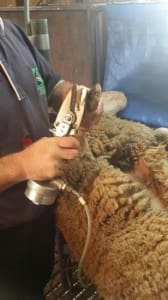 Footrot is an ongoing problem in Victorian sheep areas, with contractors treating similar numbers of sheep annually.
Footrot is an ongoing problem in Victorian sheep areas, with contractors treating similar numbers of sheep annually.
But electronic tags are helping and producers watching their business bottomline were becoming more aware of the productivity losses associated with the disease, immediate past president of the Livestock Contractors Association Jack Briscoe said.
“So they have just got to eradicate it.”
Contractors focus on disease eradication
Mr Briscoe said tens of thousands of sheep were still treated for the disease in Victoria, but he had heard that many sons returning to farms were trying to treat the disease themselves.
Other producers were being advised by veterinary consultants to do the first two inspections after paring, treatment and culling, and then get an accredited contractor in to make sure the mob is clean.
“There have been studies that have shown that a contractor will get rid of footrot quicker than what a farmer will, because of efficiency.
“And the worst part about the farmers is that not only do they look at the hooves when they are going to cull something, but they also look at the wool etcetera and put too many other factors in,” Mr Briscoe said.
“The contractor has no attachment to the sheep, the only attachment they have got is they want to eradicate footrot.”
Electronic tags making eradication easier
Mr Briscoe said it was also easier to eradicate footrot from flocks using electronic ear tags.
“We’re running them past the panel reader so making sure we are getting everything.
“It is helping to make sure that a clean muster is achieved.”
Livestock Biosecurity Network (LBN) Victorian Regional Officer Dr Patrick Kluver said the critical time is in the drier summer months, when footrot usually stops spreading.
“We can take advantage of this period by examining all sheep and removing those with evidence of infection – this is not a trivial task and many farmers who attempt this have failed.
A trained contractor is the key
However, a trained contractor with the right equipment is a key element in a successful eradication campaign,” he said.
To eradicate footrot, Dr Kluver said every toe on every sheep needs to be examined, usually for a minimum of three times over summer, into autumn.
“Any animal with evidence of footrot is culled until we get two clean musters around a month apart.”
The LBN said although it is possible for people to eradicate the disease themselves it is usually not recommended as eradication is more likely to succeed when accredited contractors are used to guide impacted livestock owners through an eradication program.
A Goulburn Ovens Institute of Tafe (GO TAFE) accredited course for contractors was held recently on a footrot affected property near Inverleigh, Victoria.
The course is a collaboration between the Livestock Contractors Association (LCA), the University of Melbourne’s Mackinnon Project, GO TAFE and LBN and is supported by the Victorian Sheep and Goat Compensation Fund.
Mr Briscoe was a course participant and said such courses offer valuable training to contractors.
“This course is ideal for anyone who is working in the field of footrot control and I’ve recommended it to all our members.”
Six Victorian, one NSW and two SA contractors were at the school.
In addition to using accredited contractors who have completed a course such as the Inverleigh event, livestock producers are also encouraged to have good on-farm biosecurity practices in place to minimise the chances of footrot infection occurring.
Biosecurity practices are important
Dr Kluver said it is absolutely essential to make sure that biosecurity practices are up to scratch before you attempt to eradicate footrot.
“There is no point in embarking on a costly eradication plan if you are just going to reintroduce it again due to poor boundary fences.”
Producers can also take other measures to lessen biosecurity risks when purchasing sheep.
“Request a sheep health statement, make sure you have read and understood it, and examine sheep for evidence of footrot before purchase,” he said.
Buyers should also run sheep through a zinc sulphate footbath when they arrive on-farm and keep them isolated from other sheep to ensure they don’t have footrot – usually this will be the end of spring, Dr Kluver said.
The LBN said producers who suspect their sheep may have footrot, should contact their local sheep veterinarian or state government department. A full list of accredited contractors is on the LCA website – www.livestockcontractors.com.
LBN is an independent industry initiative established by the Cattle Council of Australia, Sheepmeat Council of Australia and WoolProducers Australia funded over a three-year pilot period by industry levies held in trust. It provides producers with practical information about implementing on-farm animal health, welfare and biosecurity measures to deal with the many risks producers face.
To help protect their livelihood and income, producers are encouraged to complete the Farm Biosecurity Checklist at www.lbn.org.au To find out more about LBN, contact Victorian Regional Officer Dr Patrick Kluver on 0499 077 213 or visit www.lbn.org.au

the sooner we get a vaccine the better and this is the most limiting factor in the sheep industry in vic.